Satoshi Sunada
Blending Optimal Control and Biologically Plausible Learning for Noise-Robust Physical Neural Networks
Feb 26, 2025Abstract:The rapidly increasing computational demands for artificial intelligence (AI) have spurred the exploration of computing principles beyond conventional digital computers. Physical neural networks (PNNs) offer efficient neuromorphic information processing by harnessing the innate computational power of physical processes; however, training their weight parameters is computationally expensive. We propose a training approach for substantially reducing this training cost. Our training approach merges an optimal control method for continuous-time dynamical systems with a biologically plausible training method--direct feedback alignment. In addition to the reduction of training time, this approach achieves robust processing even under measurement errors and noise without requiring detailed system information. The effectiveness was numerically and experimentally verified in an optoelectronic delay system. Our approach significantly extends the range of physical systems practically usable as PNNs.
* 28 pages, 10 figures
Optical hyperdimensional soft sensing: Speckle-based touch interface and tactile sensor
Jan 06, 2024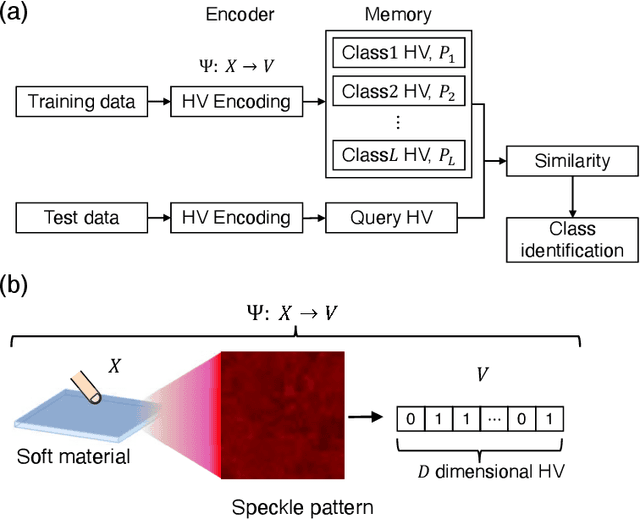
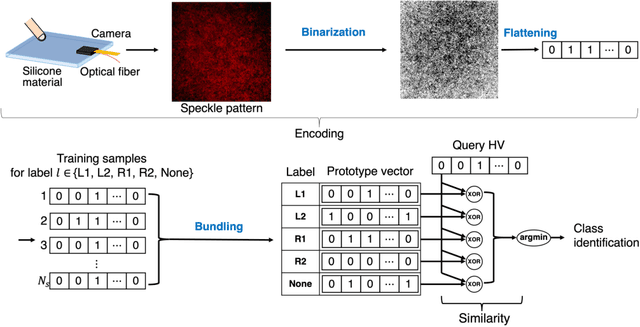
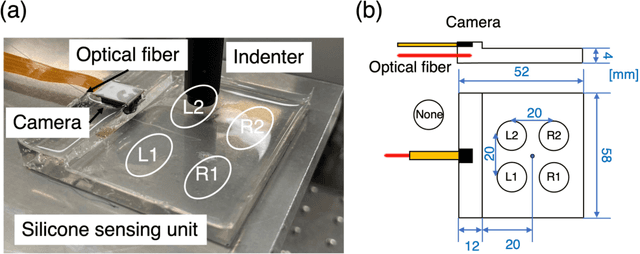
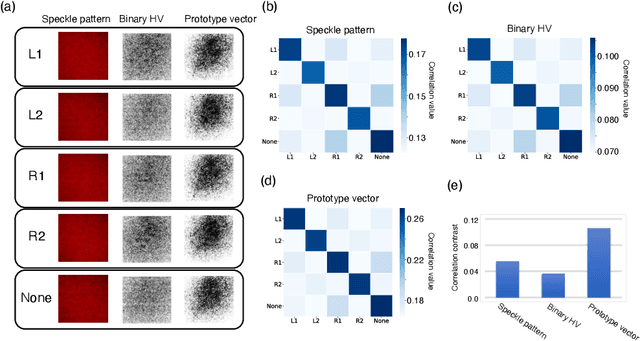
Abstract:Hyperdimensional computing (HDC) is an emerging computing paradigm that exploits the distributed representation of input data in a hyperdimensional space, the dimensions of which are typically between 1,000--10,000. The hyperdimensional distributed representation enables energy-efficient, low-latency, and noise-robust computations with low-precision and basic arithmetic operations. In this study, we propose optical hyperdimensional distributed representations based on laser speckles for adaptive, efficient, and low-latency optical sensor processing. In the proposed approach, sensory information is optically mapped into a hyperdimensional space with >250,000 dimensions, enabling HDC-based cognitive processing. We use this approach for the processing of a soft-touch interface and a tactile sensor and demonstrate to achieve high accuracy of touch or tactile recognition while significantly reducing training data amount and computational burdens, compared with previous machine-learning-based sensing approaches. Furthermore, we show that this approach enables adaptive recalibration to keep high accuracy even under different conditions.
Ultrafast single-channel machine vision based on neuro-inspired photonic computing
Feb 15, 2023Abstract:High-speed machine vision is increasing its importance in both scientific and technological applications. Neuro-inspired photonic computing is a promising approach to speed-up machine vision processing with ultralow latency. However, the processing rate is fundamentally limited by the low frame rate of image sensors, typically operating at tens of hertz. Here, we propose an image-sensor-free machine vision framework, which optically processes real-world visual information with only a single input channel, based on a random temporal encoding technique. This approach allows for compressive acquisitions of visual information with a single channel at gigahertz rates, outperforming conventional approaches, and enables its direct photonic processing using a photonic reservoir computer in a time domain. We experimentally demonstrate that the proposed approach is capable of high-speed image recognition and anomaly detection, and furthermore, it can be used for high-speed imaging. The proposed approach is multipurpose and can be extended for a wide range of applications, including tracking, controlling, and capturing sub-nanosecond phenomena.
Parallel bandit architecture based on laser chaos for reinforcement learning
May 19, 2022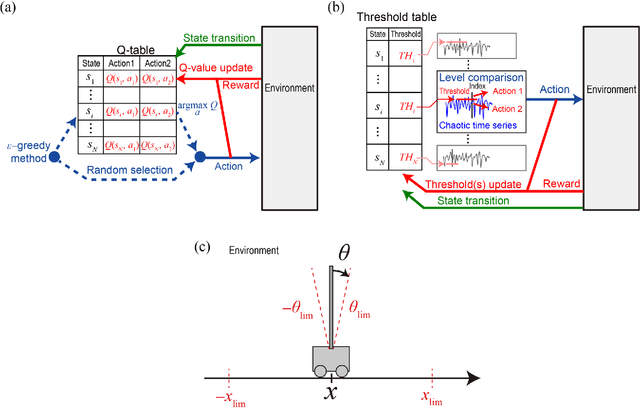


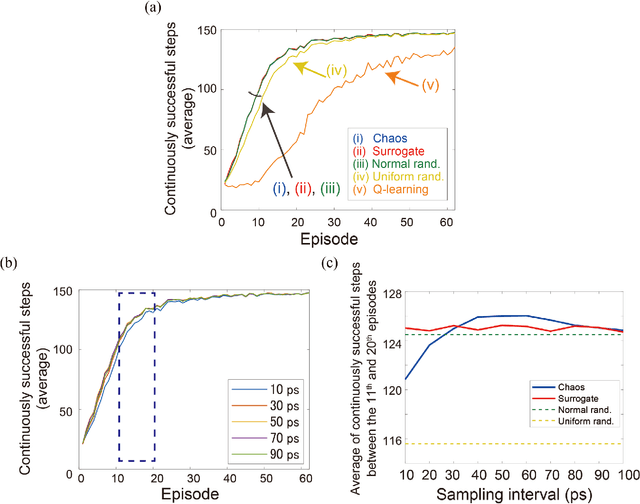
Abstract:Accelerating artificial intelligence by photonics is an active field of study aiming to exploit the unique properties of photons. Reinforcement learning is an important branch of machine learning, and photonic decision-making principles have been demonstrated with respect to the multi-armed bandit problems. However, reinforcement learning could involve a massive number of states, unlike previously demonstrated bandit problems where the number of states is only one. Q-learning is a well-known approach in reinforcement learning that can deal with many states. The architecture of Q-learning, however, does not fit well photonic implementations due to its separation of update rule and the action selection. In this study, we organize a new architecture for multi-state reinforcement learning as a parallel array of bandit problems in order to benefit from photonic decision-makers, which we call parallel bandit architecture for reinforcement learning or PBRL in short. Taking a cart-pole balancing problem as an instance, we demonstrate that PBRL adapts to the environment in fewer time steps than Q-learning. Furthermore, PBRL yields faster adaptation when operated with a chaotic laser time series than the case with uniformly distributed pseudorandom numbers where the autocorrelation inherent in the laser chaos provides a positive effect. We also find that the variety of states that the system undergoes during the learning phase exhibits completely different properties between PBRL and Q-learning. The insights obtained through the present study are also beneficial for existing computing platforms, not just photonic realizations, in accelerating performances by the PBRL algorithms and correlated random sequences.
Controlling chaotic itinerancy in laser dynamics for reinforcement learning
May 12, 2022



Abstract:Photonic artificial intelligence has attracted considerable interest in accelerating machine learning; however, the unique optical properties have not been fully utilized for achieving higher-order functionalities. Chaotic itinerancy, with its spontaneous transient dynamics among multiple quasi-attractors, can be employed to realize brain-like functionalities. In this paper, we propose a method for controlling the chaotic itinerancy in a multi-mode semiconductor laser to solve a machine learning task, known as the multi-armed bandit problem, which is fundamental to reinforcement learning. The proposed method utilizes ultrafast chaotic itinerant motion in mode competition dynamics controlled via optical injection. We found that the exploration mechanism is completely different from a conventional searching algorithm and is highly scalable, outperforming the conventional approaches for large-scale bandit problems. This study paves the way to utilize chaotic itinerancy for effectively solving complex machine learning tasks as photonic hardware accelerators.
Optical skin: Sensor-integration-free multimodal flexible sensing
Feb 03, 2022Abstract:The biological skin enables animals to sense various stimuli. Extensive efforts have been made recently to develop smart skin-like sensors to extend the capabilities of biological skins; however, simultaneous sensing of several types of stimuli in a large area remains challenging because this requires large-scale sensor integration with numerous wire connections. We propose a simple, highly sensitive, and multimodal sensing approach, which does not require integrating multiple sensors. The proposed approach is based on an optical interference technique, which can encode the information of various stimuli as a spatial pattern. In contrast to the existing approach, the proposed approach, combined with a deep neural network, enables us to freely select the sensing mode according to our purpose. As a key example, we demonstrate simultaneous sensing mode of three different physical quantities, contact force, contact location, and temperature, using a single soft material without requiring complex integration. Another unique property of the proposed approach is spatially continuous sensing with ultrahigh resolution of few tens of micrometers, which enables identifying the shape of the object in contact. Furthermore, we present a haptic soft device for a human-machine interface. The proposed approach encourages the development of high-performance optical skins.
Photonic neural field on a silicon chip: large-scale, high-speed neuro-inspired computing and sensing
May 22, 2021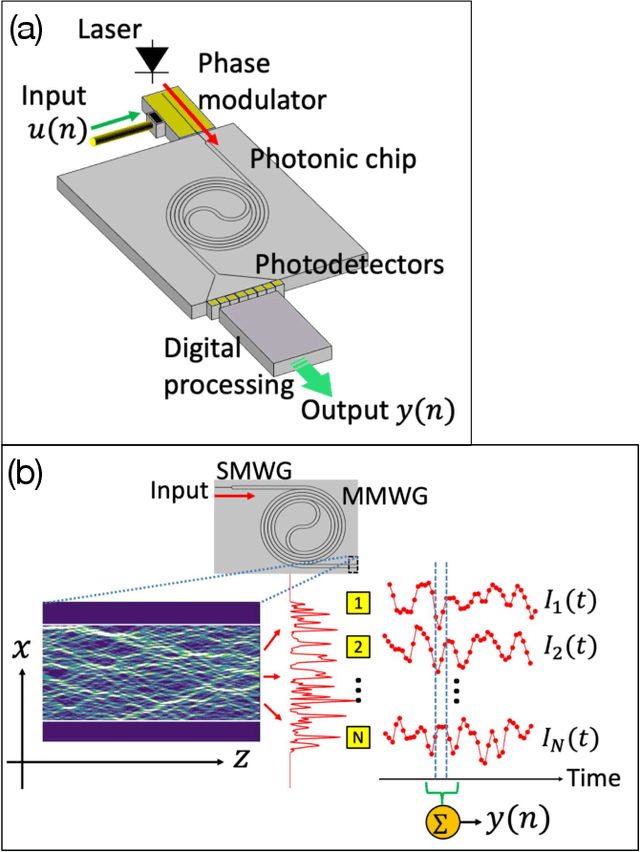
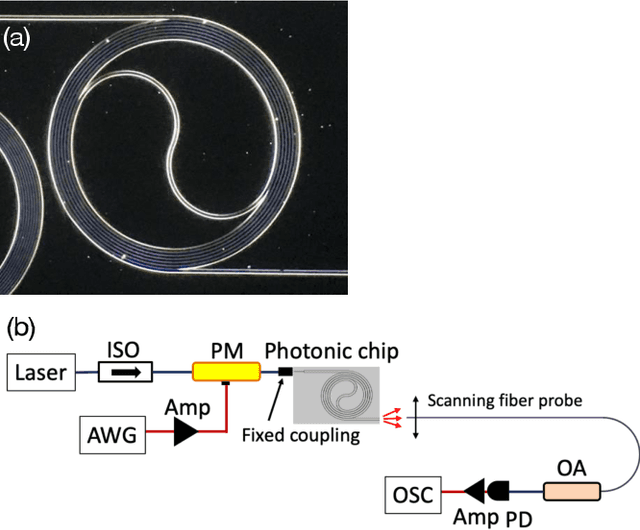
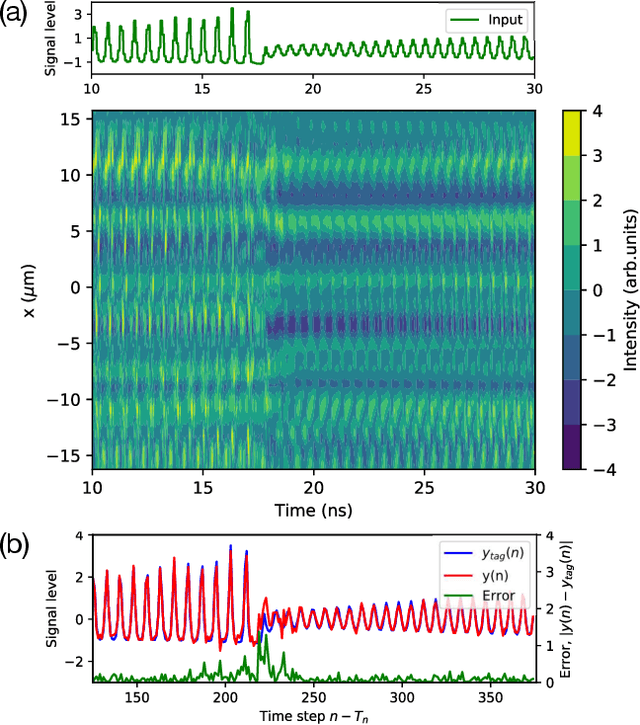
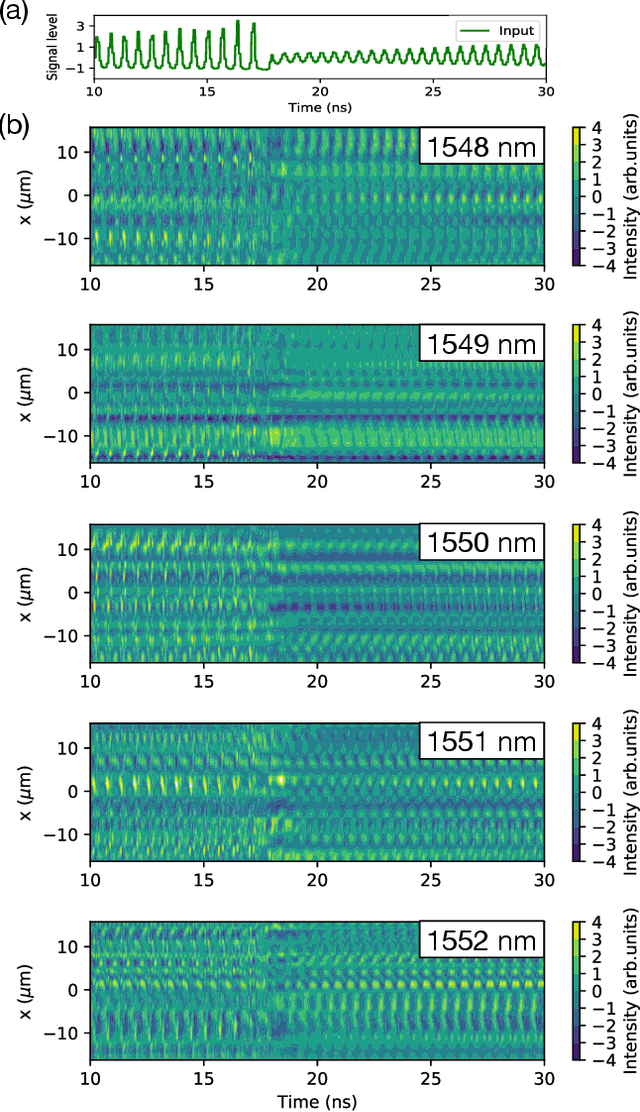
Abstract:Photonic neural networks have significant potential for high-speed neural processing with low latency and ultralow energy consumption. However, the on-chip implementation of a large-scale neural network is still challenging owing to its low scalability. Herein, we propose the concept of a photonic neural field and implement it experimentally on a silicon chip to realize highly scalable neuro-inspired computing. In contrast to existing photonic neural networks, the photonic neural field is a spatially continuous field that nonlinearly responds to optical inputs, and its high spatial degrees of freedom allow for large-scale and high-density neural processing on a millimeter-scale chip. In this study, we use the on-chip photonic neural field as a reservoir of information and demonstrate a high-speed chaotic time-series prediction with low errors using a training approach similar to reservoir computing. We discuss that the photonic neural field is potentially capable of executing more than one peta multiply-accumulate operations per second for a single input wavelength on a footprint as small as a few square millimeters. In addition to processing, the photonic neural field can be used for rapidly sensing the temporal variation of an optical phase, facilitated by its high sensitivity to optical inputs. The merging of optical processing with optical sensing paves the way for an end-to-end data-driven optical sensing scheme.
Physical deep learning based on optimal control of dynamical systems
Dec 16, 2020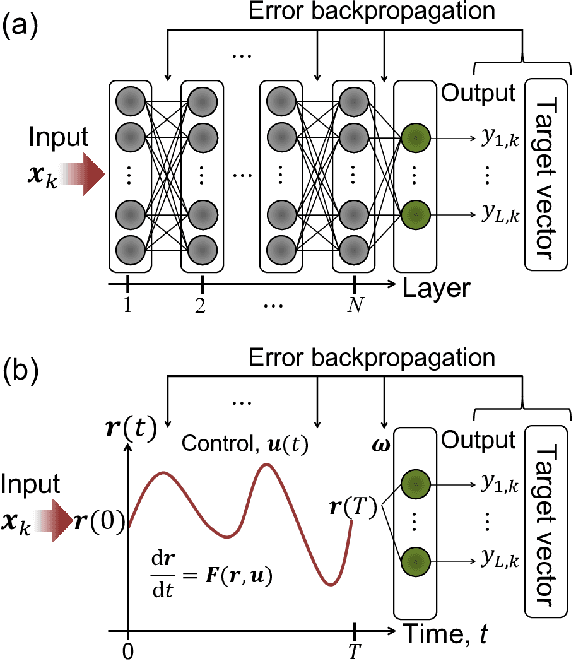
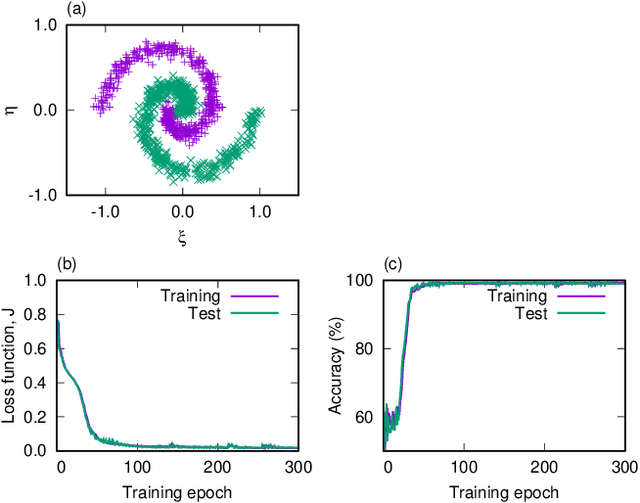
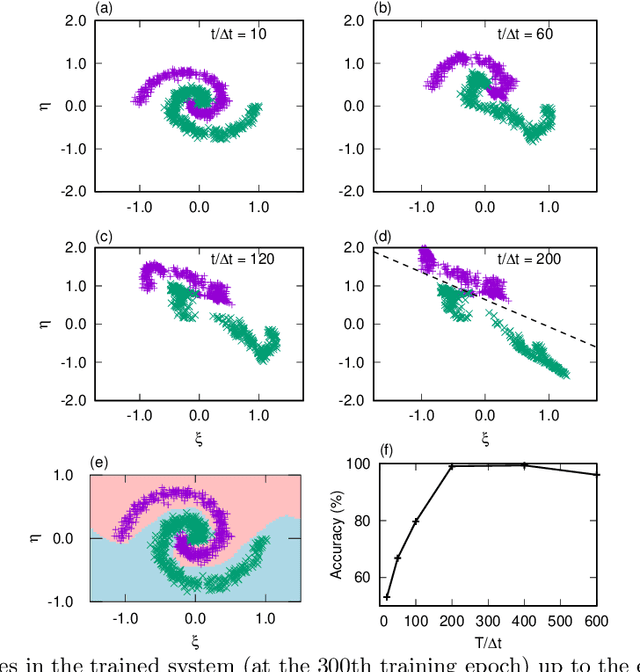
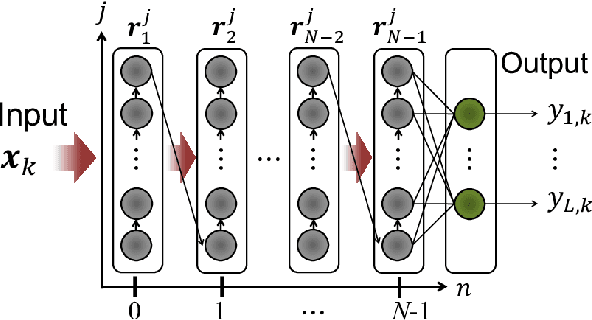
Abstract:A central topic in recent artificial intelligence technologies is deep learning, which can be regarded as a multilayer feedforward neural network. An essence of deep learning is the information propagation through the layers, suggesting a connection between deep neural networks and dynamical systems, in the sense that the information propagation is explicitly modeled by the time-evolution of dynamical systems. Here, we present a pattern recognition based on optimal control of continuous-time dynamical systems, which is suitable for physical hardware implementation. The learning is based on the adjoint method to optimally control dynamical systems, and the deep (virtual) network structures based on the time evolution of the systems can be used for processing input information. As an example, we apply the dynamics-based recognition approach to an optoelectronic delay system and show that the use of the delay system enables image recognition and nonlinear classifications with only a few control signals, in contrast to conventional multilayer neural networks which require training of a large number of weight parameters. The proposed approach enables to gain insight into mechanisms of deep network processing in the framework of an optimal control problem and opens a novel pathway to realize physical computing hardware.
Lotka-Volterra competition mechanism embedded in a decision-making method
Jul 29, 2019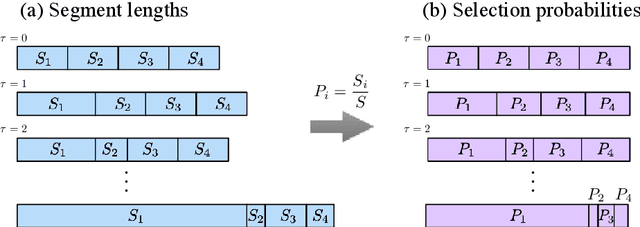

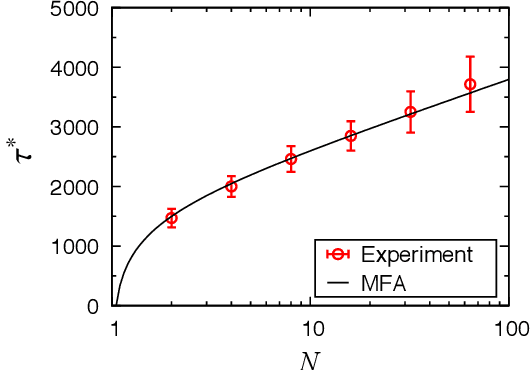
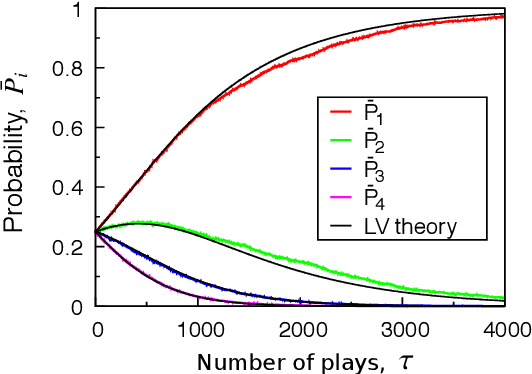
Abstract:Decision making is a fundamental capability of living organisms, and has recently been gaining increasing importance in many engineering applications. Here, we consider a simple decision-making principle to identify an optimal choice in multi-armed bandit (MAB) problems, which is fundamental in the context of reinforcement learning. We demonstrate that the identification mechanism of the method is well described by using a competitive ecosystem model, i.e., the competitive Lotka-Volterra (LV) model. Based on the "winner-take-all" mechanism in the competitive LV model, we demonstrate that non-best choices are eliminated and only the best choice survives; the failure of the non-best choices exponentially decreases while repeating the choice trials. Furthermore, we apply a mean-field approximation to the proposed decision-making method and show that the method has an excellent scalability of O(log N) with respect to the number of choices N. These results allow for a new perspective on optimal search capabilities in competitive systems.
 Add to Chrome
Add to Chrome Add to Firefox
Add to Firefox Add to Edge
Add to Edge